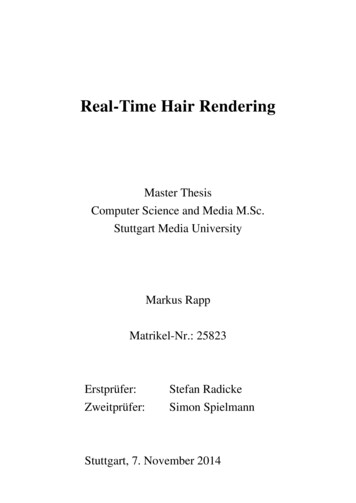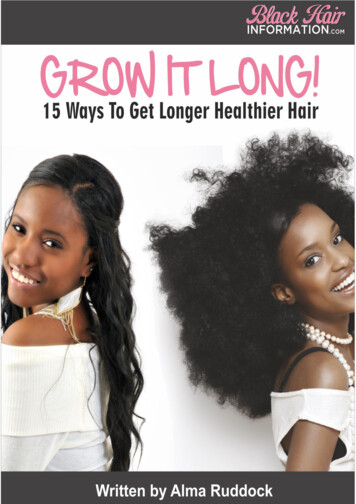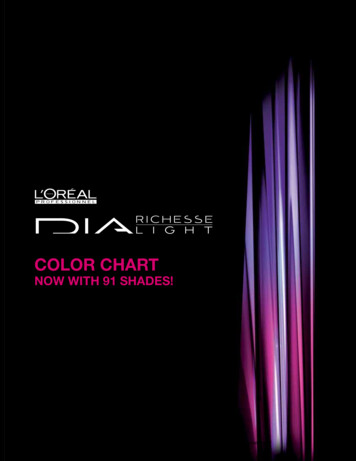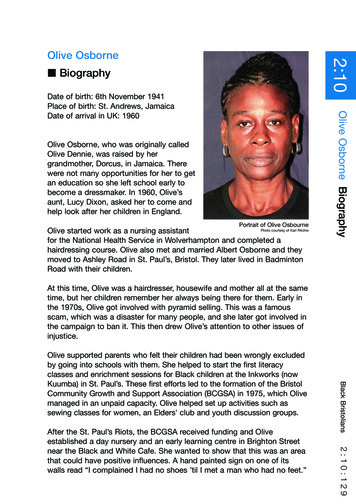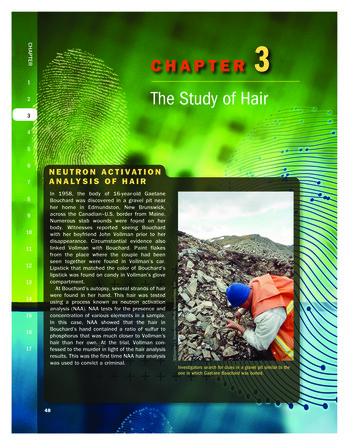
Transcription
Forensic HairComparisonsMax M. HouckDirector, Forensic Science Initiative, Research OfficeManager, Forensic Business Research and Development,College of Business and Economics
Specific questions What is the state of the art?– I hope this presentation demonstrates thestate of the art Where is research conducted?– Little research is conducted in forensic hairexaminations, except for mtDNA Where is it published?– When conducted, it is published in peerreview journals
Basis of forensic hair microscopy Comparative biology, including medicine andphysical anthropology, has a long history ofmicroscopic identification and comparison datingback to the 18th century.– Comparison is the cornerstone of the majority ofbiology, both past and present. Microscopic techniques, combined with studiedexperience, provide for a discriminating meansto examine and compare hair. Literature in physical anthropology and forensicscience detailing the differences betweenpeoples’ hair supports the credibility of thescience
Victim and Criminal onlyinteract at a Crime Sceneunfamiliar to bothVictim and Criminal interact at aCrime Scene familiar to bothEx. Spouse kills co-habitatingspouseEx. Sexual assault in an alleyVictim and Criminal interactat a Crime Scene familiaronly to the CriminalEx. Kidnapping and assault inCriminal’s houseVictim and Criminal interactat a Crime Scene familiar onlyto the VictimVictimCriminalCrime SceneEx. Home invasion
What can be determined? Is it a hair?Is it human?What area of the body is it from?What is the person’s ancestry?Is there damage, disease, treatment?Is it suitable for comparison?
DeerMinkDogGoat
Human head hair
What area of the body is itfrom? HeadPubicFacialLimbChestAxial (armpit)These carry themost information formicroscopiccomparisons
European ancestry head hair
African ancestry head hair
Asian ancestry head hair
European ancestry pubic hair
Pubic area hair
Determination of Racial Origin European ancestry “Caucasian” African ancestry “Negroid” Asian ancestry “Mongoloid”
European ancestry Shaft diameter moderate with minimalvariation Pigment granules sparse to moderatelydense with fairly even distribution Oval cross-sectional shape
European Ancestry Head hairs - cross-section
African ancestry Shaft diameter fine to moderate withconsiderable variation Pigment granules densely distributed andarranged in clumps Flattened cross-sectional shape
African ancestry head hairs - cross section
Asian ancestry Shaft diameter coarse, little or no variation Pigment granules densely distributed andarranged in large patches or streaks Prominent medulla (broad and continuous) Cuticle thick Round cross-sectional shape
Asian ancestry head hairs - cross section
Damage/disease/treament
Damage BreakingBurningPutrefied rootsInsect marksCuttingCrushing
Insect chewing
Putrefied roots
Artificial Treatment Bleachingllsolarchemical Dyeing
Is it suitable forcomparison? Unsuitable hairs–––––DamagedToo shortToo light in colorFragmentExtreme treatment Suitable hairs may be compared with suitableknown hair samples of the same type– Head to head; pubic to pubic
Suitable known sample Must be representativeSample all areas of the headMinimum of 25-50 hairsCombed and plucked hairsInclude any hair weaves, braids, etc.
Comparison process Uses a comparison microscope– Two microscopes optically joined– Split-screen view Two samples side-by-sidesimultaneously Use all characteristics available Questioned hair must fall within variationestablished by the Known sample
Tip NaturalCutBrokenAbraded, split
Cuticle Color Thickness Damage
Scales SizeProtrusionLoopingDamage
Cortex Cortical cells - spindle shaped Visible or not
Pigment ArrangementDistributionDensitySize of granulesGapping
Medulla Presence or absence Thickness Fragmentary, discontinuous,continuous Clear or opaque Cellular or smooth
Ensembles of Class Traits1All human hairsAll head hairsAll Caucasian HHsAll Brown COHHsNext slide.All hairs1 Thornton,JFS, 1986
Ensemble of Class Traits Rootabundant fusitelogenanagendecompstretchedfollicular tagTipcutbrokensplitpointedroundWidth coarsefinevariation along shaftvariation w/in sampleCuticle thicknessvariation in thicknessclaritycolorScales protrusionslightmediumgreat uationMedulla sopaquecontinuouscell shapethickthinmedium CortexPigmentCosmeticSpecialcells prominentcells obscuredsize of granulesshape of granulesdensitylocal distributionpatchystreakychainingdistribution w/in shaftgappingshallowshortmediumdeeplongpigment in cuticlebleacheddyedlength of time since treatmentcracked cuticleovoid bodiesdouble medulladiseasesvermin
InclusionExclusion
Conclusions: Inclusion The Q1 head hair exhibits the samemicroscopic characteristics as the K1head hairs and, accordingly, could havecome from the same source. It should be noted that the microscopiccomparison of hairs is not a method ofpositive identification.
Conclusions: Inconclusive The Q1 head hair exhibits similarities toand differences from the K1 head hairsample. Accordingly, no conclusioncould be made as to whether Q1 and K1could have had a common source.
Conclusions: Exclusion The Q1 head hair is microscopicallydissimilar to the K1 head hair sampleand, accordingly, could not have comefrom the same source.
MtDNA and hair About 93% of hairs provide mtDNA info1– 1.0 cm of hair is typically sufficient– Hairs up to 30 years with no significantenvironmental damage still work– Rate of heteroplasmy is about 9-14% With telogen roots, hair success rate isindependent of– cosmetic hair treatments; medullastructure; shaft length, diameter, andvolume; and scalp origin.21Melton,et al., JFS V50, N1, 20052Roberts and Calloway, JFS V52, N1, 2007
Reliability and reproducibility Several clinical studies and research projects withpublished and peer reviewed reports have demonstratedthat given a limited number of questioned and known hairsamples, correct inclusions and exclusions are the rulerather than the exception Bisbing and Wolner, 1984; Lamb and Tucker, 1994;Gaudette, 1976; Gaudette and Keeping, 1974; Strauss,1983; Wickenheiser and Hepworth, 1990; Houck andBudowle, 2002
Clinical studiesStudyGaudette (h)Year1974Results.9 in 366,630 pairs (1 in 40,737 pairs)Strauss (h)19830 in 4,900 pairsWickenheiser (h)19907 in 431,985 pairs (1 in 61,712 pairs)Gaudette (p)197616 in 101,368 pairs (1 in 6,336 pairs)Proficiency Tests 1995 8% error rateHouck and Budowle 2002Of 127 cases, 9 excluded by mtDNA
Houck and Budowle, 2002
Specificity/selectivity Blood-typing indicates that a crimescene stain and the suspect were bothType A blood– Later excluded by DNA– But the blood typing was correct, in so far as itgoes This is analogous with microscopicalhair comparisons– Just because the mtDNA does not “match”does not mean the questioned hair does notexhibit the same characteristics as the knownsample
Specific questions Where are new developments coming from? What are the major problems in the scientificfoundation or methods and in the practice?– Training and quality– Support from lab directors, attorneys, and police– Adequate resources: Money. What research questions can be answered?– Specificity/selectivity; animal hairs; geneticcomponent of traits;
Basis of forensic hair microscopy Comparative biology, including medicine and physical anthropology, has a long history of microscopic identification and comparison dating back to the 18th century. – Comparison is the cornerstone of the majority of biology, both past an


